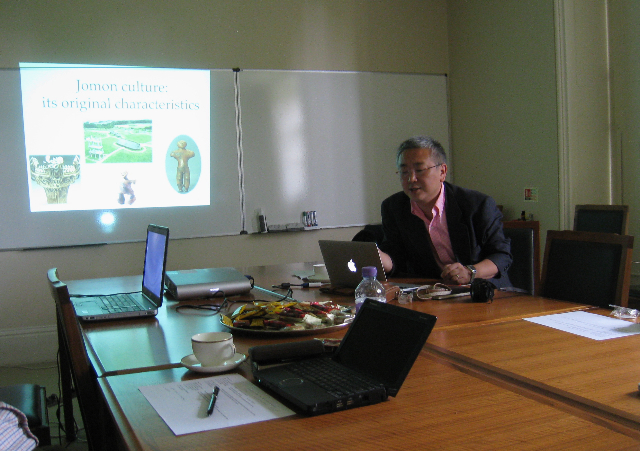Oxford meeting of the Core-to-Core programme
August 1, 2013
Dr. Rick Schulting kindly provided the following update re our recent 2-day Core-to-Core programme seminar in Oxford:
Oxford meeting of the Core-to-Core programme
A two day seminar was held in Oxford July 4th and 5th, marking the first meeting of a new Core-to-Core programme headed by Professor Hirofumi Kato of the University of Hokkaido, Japan. Following an introduction to the aims of the programme, Professor Kato gave an overview of Jomon culture in Japan, one of the longest-lived archaeological traditions in the world, extending from ca. 10,000 to 300 BC, and surviving longer than this in the north of the archipelago. This was followed by Professor Minoru Yoneda's (University of Tokyo) overview of stable isotope research on human remains from the Japanese archipelago, covering all periods from the Palaeolithic to medieval and even modern Japan. This work has revealed considerable regional diversity in diets, and is beginning to identify some very intriguing differences at much smaller spatial skills, sometimes within the same site. This theme was continued in the afternoon with talks by Professor Julia Lee-Thorp and Dr Rick Schulting, summarising stable isotope research on Holocene hunter-gatherers in South Africa and Europe, respectively.
The next day began with Professor Chris Ramsey's overview of Bayesian modelling of radiocarbon dates, as well as a report on recent work concerning freshwater reservoir corrections for dates on prehistoric human remains from the Lake Baikal region of Siberia. Dr Hiromasa Ozaki next presented his work on creating a calibration curve specific to Japan, noting offsets from IntCal09's northern hemisphere curve. Greater similarities with the southern hemisphere curve suggest that at least the southern half of Japan is affected by global weather patterns, specifically the summer monsoon. Dr Takayuki Omori then discussed the available radiocarbon chronology for the Kanto region of Japan, with its incredibly rich record of activity during the Middle Jomon period. The very detailed pottery typology that has been developed in the region by Professor Tatsuo Kobayashi is further supported by Bayesian analysis, indicating very rapid changes in pottery styles occurring almost every generation.
One of the advantages of small workshop seminars is the much greater time they allow for discussion. This touched upon a number of themes, including hunter-gatherer stability and change, identity, responses to environmental change, the impact of incoming farming communities, and the need for high-resolution chronologies. A number of interesting parallels between Japan and Britain/Ireland were noted in terms of their positions as island chains immediately adjacent to the continent, and the unique character that this provided in terms of a combination of isolation and communication. This was especially apparent in the process of the arrival of developed farming practices in the Yayoi period in Japan, and the Neolithic for Britain and Ireland.
The Core-to-Core is funded by the Japan Society for the Promotion of Science, and will run for five years, with meetings to be held in Japan, Canada and the UK.

Professor Hirofumi Kato in Oxford.